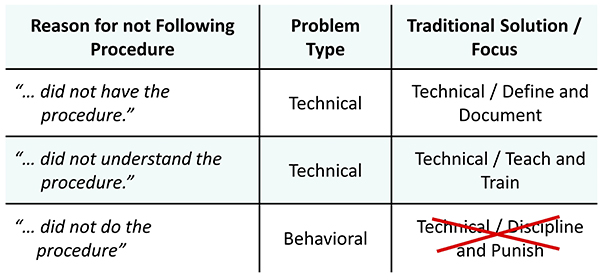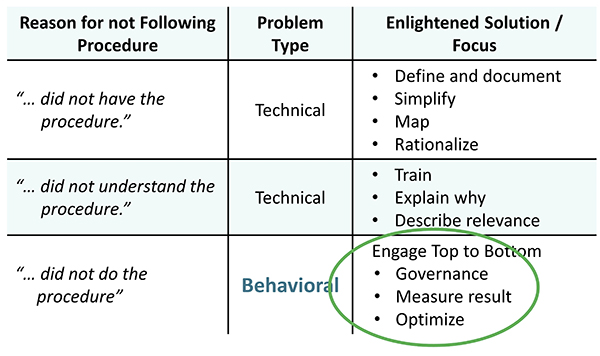Posts
IADC Highlights: Procedural Adherence Video
/in Engagement /by Kaufman GlobalIf you weren’t able to join us at the 2017 IADC Human Factors Conference in Galveston last month, you missed out on a rich dialog. Kaufman Global President Jerry Timpson presented on the topic of Procedural Adherence – why people break the rules, how individuals and the enterprise approach risk differently, and what can be done about it. See his post-presentation interview with Kelli Ainsworth from DrillingContractor.org below.
Procedural Adherence: October 2017 IADC Human Factors Conference
/in News and Events /by Kaufman Global Procedural Adherence is the topic Kaufman Global president Jerry Timpson will speak on at this year’s IADC Human Factors Conference and Exhibition. The conference takes place 17-18 October at the Moody Gardens Hotel in Galveston, Texas.
Procedural Adherence is the topic Kaufman Global president Jerry Timpson will speak on at this year’s IADC Human Factors Conference and Exhibition. The conference takes place 17-18 October at the Moody Gardens Hotel in Galveston, Texas.
Mr. Timpson will present during the 10:45-11:15 am session on Tuesday, 17 October. His presentation is entitled: On Procedural Adherence. Procedural Adherence is about behaviors. Many organizations focus on the technical side of procedural adherence (documentation and training), but don’t do so well with the behavioral aspect. Often the first indicator of a procedural or process problem is when a major malfunction occurs, a catastrophic event. Smaller, less obvious issues result in major loss, but are often not addressed at all. To improve outcomes, we must shift values, engage the organization in different ways and establish new behaviors that are leading indicators of procedural and process adherence.
For a preview of this topic, download our On Procedural Adherence white paper from our Resources page.
Conference attendees are invited to connect with us in Galveston to discuss how Kaufman Global helps client in the oil and gas industry leverage Lean and Continuous Improvement methods to create a workplace of safety and operational excellence. Drop us a line and set up a time to say hello!
**********
About IADC
Since 1940, the International Association of Drilling Contractors (IADC) has exclusively represented the worldwide oil and gas drilling industry. IADC’s mission is to catalyze improved performance for the drilling industry by enhancing operational integrity and championing better regulation to facilitate safer, cleaner and more efficient drilling operations worldwide. For more information, visit the IADC website at www.iadc.org.
About IADC Human Factors Conference
Recent events have triggered a growing awareness of the human contribution to catastrophic and process safety events. As other industries have proven, if the drilling industry can make a concerted effort to understand human factors and integrate these concepts into training and operations, significant value can be gained in terms of safety performance. The IADC Human Factors Conference & Exhibition will seek to examine the innovations that are shaping the future of drilling as it strives to merge rapidly advancing technologies with an understanding of human nature and form.
Procedural Adherence: Your Problem is Bigger than Technology
/in Change Management, Whitepapers /by Kaufman GlobalProcedures are Rules
They are the standard practices that organizations use to do things in a consistent way. There is incentive to adhere to procedures. With better procedural adherence (PA), the business is more effective in the work that it does. More efficient too. But rules are not always followed. There are three reasons why:
- Procedures are not defined.
- People are not trained on the procedures
- Procedures are not followed.
A Behavioral Problem
The key to understanding the issue of procedural adherence – that is; why people don’t follow the rules, is knowing that the problem is behavioral, not technical. Sure, you may have some technical issues – like undocumented and poorly trained procedures, but these are less difficult to solve. It’s worth noting however, that there are plenty of opportunities with definition, documentation and training. The following chart shows the traditional response to the problem:

A Behavioral Problem
The most common response to someone not following a procedure – the behavioral problem – is punishment. Punishment is a technical solution. It may address a specific instance of rule-breaking but for every rule enforced with discipline, there are dozens of others not. It’s not an optimal solution and it won’t cause broad compliance or prevent catastrophic failures. To change the status quo, where procedures are randomly and frequently broken, requires a behavioral response because it’s a behavioral problem.
The Target for Better Rule Following

The most common target audience for process standardization and procedural adherence has been the front line of the organization. Within that population, efforts are often focused on repetitive processes like those found in manufacturing. This needs to change. Enlightened businesses extend their efforts to administration, service delivery, field operations, and so on. Even greater opportunities exist at the top and in the middle of the organization. Focusing procedural adherence efforts here can deliver major benefits and value because ultimately it drives the rest of the organization. It is here, at the top, that here behavioral change must start.
Building Blocks for Procedural Adherence
The chart below shows the basic elements of better procedural adherence.

Each of the solutions for the three elements: Have procedures / Understand procedures / Do Procedures / is customized. Technical problems have technical solutions. The behavioral issue is met with a change in behaviors starting at the top. When leadership engages and pays attention to procedural adherence as something that is valued, people pay attention, compliance begins and behaviors start to change throughout.
Procedural Adherence Defined
Procedural adherence means executing against a defined set of standards in a particular way, even when it’s possible that alternative approaches could achieve the same result. When standards are arbitrary, we get chaos ― an environment where infinite possibilities exist and individual preferences prevail, which leads to outcomes that are anything but certain and, more importantly… provides no baseline upon which to build systematic improvements.
Ready to dig deeper? This article is continued in our White Paper: On Procedural Adherence. Click here to register and download the document. In the paper you’ll learn about why the risk profiles for the enterprise are different than for the individual. This mismatch is a major driver of procedural adherence problems.
—
Kaufman Global presented Procedural Adherence at the IADC Human Factors Conference in Galveston Texas Oct. 17-18, 2017. If you would like to run through this presentation, contact us and we’ll set up a call.
